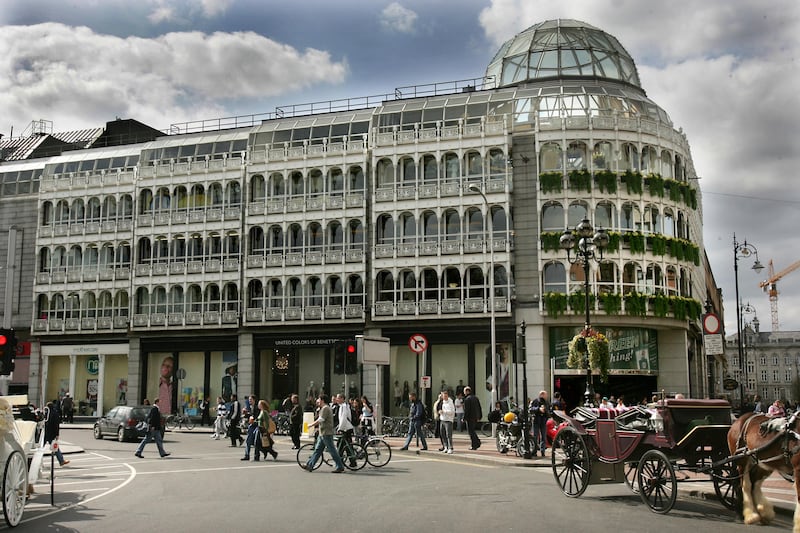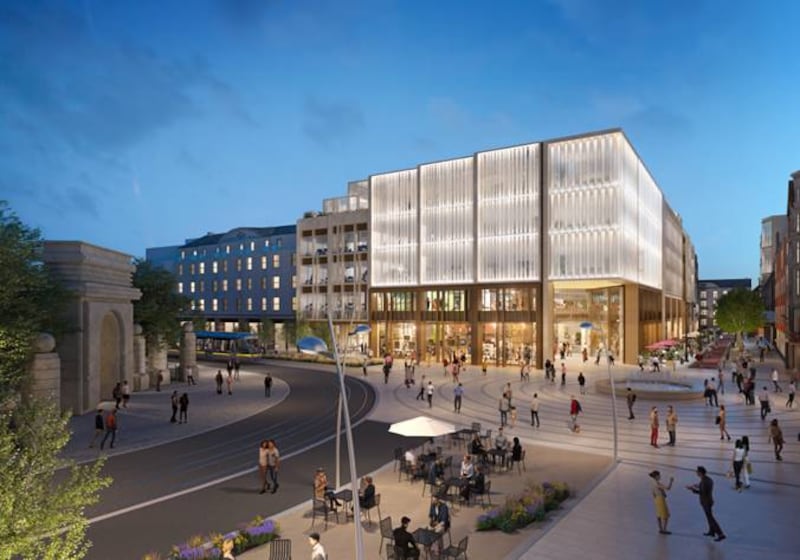Once in a while – all too frequently, actually – a new plan for a “redevelopment” in Dublin city centre comes along that is so deflating and so enraging that the only thing to do is either sigh or fight.
The proposed “redevelopment” (another term for aesthetic and architectural destruction) of St Stephen’s Green shopping centre is one such plan. What is being proposed is astonishingly bland and ugly. Seeing the images of what will replace what currently exists makes me almost recoil. Why on earth is this happening? Because it is happening. Dublin City Council has granted planning permission. The iconic dome? Gone. The white ornate facade? Gone. The hanging baskets? Gone. The vast sense of sky, air and light on the inside? Gone.
I gave former environment editor of The Irish Times, Frank McDonald – who will be lodging an appeal with An Bord Pleanála regarding the development – a call to discuss the “redevelopment”. McDonald pointed out multiple issues with the plan itself, but also the importance of the shopping centre as an iconic building at the top of Grafton Street. The building is featured on postcards, he said, and it’s an emblem of Dublin, loved by locals and visitors alike. Dublin city centre does not need more offices right now, which also feature in the redevelopment.
“The Dublin City Council planning authority has been far too indulgent of office schemes stacked around St Stephen’s Green,” he said. “St Stephen’s Green is a national monument. That is really important as a context. I just don’t think people are taking into account the heritage aspect of all of this.”
This Friday is the deadline for appealing the planned redevelopment. When those appeals are lodged – and there will be at least two very thorough ones – the public will then be entitled to make submissions based on those appeals (this costs €50 per submission) up until around mid-February. So this is now a moment – if we want this building to be preserved in its current form – for the public to act on what they want to save.

From my perspective, I feel we have really had enough of this kind of dross-development in Dublin city centre. I am sick of the bland and the generic. It is not a fait accompli that Dublin city should submit fully to the bore-core reflexes of developers for the sake of their profit. We need to preserve the character of what remains that holds aesthetic value.
[ Grafton Street investment for €2.5m offers prime city centre opportunityOpens in new window ]
Given how iconic the current building is, and its location, this is a fork-in-the-road moment. We have a choice to make about whether the city should continue to move in the direction of buildings that appear cheap, trashy, generic, bland, nondescript, ugly, flimsy – worse than what has come before. Hostile development of this nature doesn’t just erase the character of the city, it harms the ambience of the place. Feeling angry or disappointed or depressed by the latest nonsense structure that has been thrown up is relevant. Feeling uplifted, calmed, and delighted by one’s surroundings is important. Experiencing beauty is fundamental to our lives.

This is not about being sentimental or nostalgic. It’s about standards. It’s about pleasure. It’s about understanding that “change” – and cities are characterised by change – should mean an improvement, not a regression.
[ Stephen’s Green Shopping Centre owners revamp plansOpens in new window ]
In this context, people do actually have power. We saw that in a spectacular way when the public mobilised against the ridiculous plans to plonk a hotel on top of the Cobblestone pub in Smithfield in Dublin 7, taking a chunk of it away in the process. That resulted in the highest level of engagement from the public with Dublin City Council on a proposed development, ever. It also meant, to its credit, that Dublin City Council listened, and recognised the cultural value and importance of what is a bastion of traditional music in the city. There were protests and petitions. The Cobblestone was saved.
The same can happen now with St Stephen’s Green shopping centre if people are willing to make the effort. Yes, the building is kitsch. There’s value in that. It’s fun. It’s distinctive. It’s ornate. Its dome and facade are beautiful. The interior – with that huge atrium and extraordinary see-through clock – has a sense of grandeur. It feels special.
In years to come, if this plan goes ahead, long after the facade and dome of the shopping centre are demolished, this building will occupy the same set of archive photography of so many Dublin buildings that were pleasant to look at, and had aesthetic value, but were knocked so that blandness could prevail. People will look at the image of what was and compare it in their mind’s eye to what is. They will wonder why something unique was torn down for something generic. They will position it as yet another example of degradation in the urban environment. They will be confounded by how on earth we hadn’t learned the lessons of knocking all those beautiful theatres and cinemas, Georgian buildings, brutalist gems and warehouses.
[ Dublin’s disappearing venues: A promised 500-seat theatre is shrouded in mysteryOpens in new window ]
So, do you care? Because unless the public mobilises, in a few years, you’ll be walking by, and your head will drop. You’ll think: remember the old shopping centre? That was beautiful, wasn’t it?
This article was updated on January 18th 2024 to replace an image of an earlier proposal with the design recently granted planning permission





